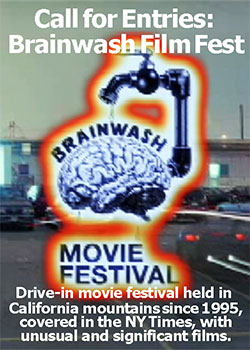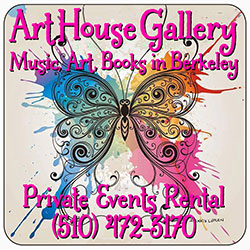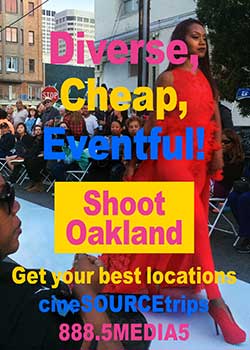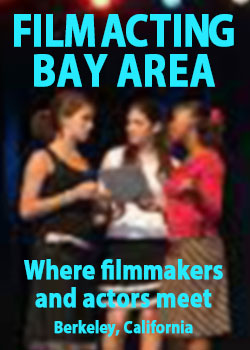Radical Multiculturalism to the Rescue
by Doniphan Blair
Please support our stories by liking articles—thanks!
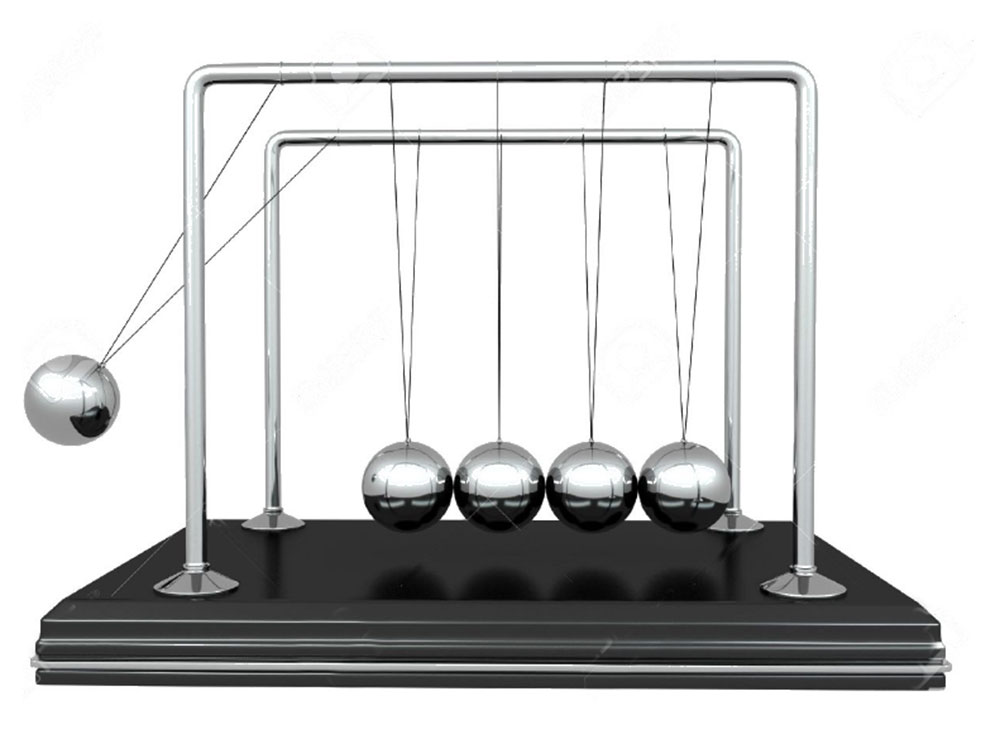 'For every action, there is an equal and opposite reaction' is Isaac Newton's third law of motion. photo courtesy: Perpetual Motion PendulumTHE PROBLEM WITH REVOLUTIONS IS
'For every action, there is an equal and opposite reaction' is Isaac Newton's third law of motion. photo courtesy: Perpetual Motion PendulumTHE PROBLEM WITH REVOLUTIONS IS
that people rarely do as you say, but they often do as you do.
Hence, a common reaction to a revolution is counterrevolution, unless the previous regime was totally tyrannical. That is why revolutions, no matter how progressive, are obliged to be repressive.
The same is true when it comes to emphasizing tribe, profession, politics or other identifying factors. Your opponents pay you the highest compliment by doing not as you say but as you do—albeit from their perspective.
The truly brilliant revolutionary, therefore, is the radical centrist who resists the temptation to idealism, self-aggrandizement or score settling and is tolerant, generous and understanding of this normative feature of human nature. They fight for the most radical change possible, through a strategy of sophisticated moderation, while avoiding counterproductive counterrevolutions.
Which brings us into the teeth of America’s current catastrophe.
As Americans stagger through the quadruple threat of pandemic, social unrest, economic collapse and the most fraught election in memory, if not our history, we have a vast array of communities both at each other’s throats and arming themselves, sometimes literally, for escalated conflict, perhaps sanguineous.
But there is another story behind this narrative. For all America’s past slavery and genocide and ongoing prejudice and oppression, now inflamed by President Trump, it remains the most multicultural society on the planet.
How many Blacks, Jews, Italians, Irish or Mexicans does China have?
Even if China evolves beyond its repression of counterrevolutions, actual or perceived—like the Uighurs, over a million of whom are now in concentration camps—can it become a functional nation, let alone a super power, without the capacity to tolerate and integrate difference?
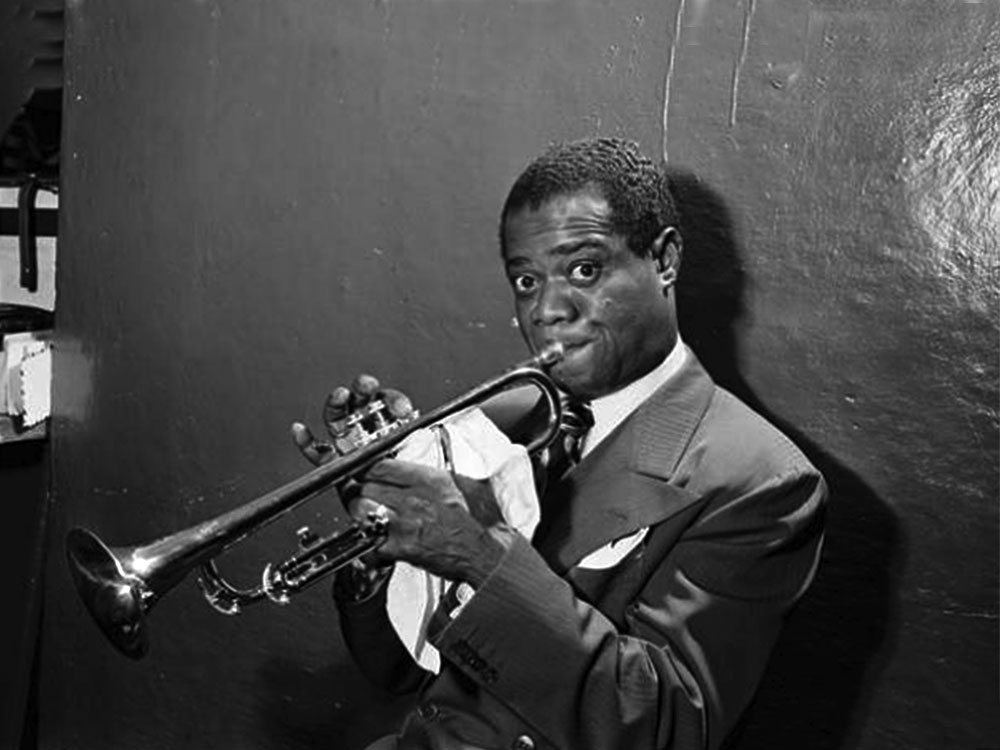 Considered an 'Uncle Tom' by some radicals, Louis Armstrong largely invented modern jazz, was close friends with whites and Jews and smoked weed everyday of his adult life. image: The Louis Armstrong House Museum Have you ever visited Ur-liberal Holland and observed how they ghettoize their immigrants and then retreat to their neighborhood bars, where even full fluency in Dutch won’t earn you acceptance?
Considered an 'Uncle Tom' by some radicals, Louis Armstrong largely invented modern jazz, was close friends with whites and Jews and smoked weed everyday of his adult life. image: The Louis Armstrong House Museum Have you ever visited Ur-liberal Holland and observed how they ghettoize their immigrants and then retreat to their neighborhood bars, where even full fluency in Dutch won’t earn you acceptance?
For a multicultural society to work, to efficiently organize the cooperation of people with different worldviews and practices, it requires a lot of radical centerists.
Yes, America seems like one long bloodbath to its immigrants, its forced immigrants and its First People—for good reason, of course—but it is not quite so grotesque after we compare America to other nations.
For a really long and vicious conflict try Islam, which is still fighting its civil war between the Sunnis and Shia, which started in the 7th century.
The Europeans had the Hundred Years War, the Eighty Years War, the Thirty Years War, the Seven Years War, and finally their magnum opus: the First and Second World Wars and the Holocaust, in which almost every European nation participated to some extent.
That three-part, 90-million-people, grave-digging contest only ended with American military intervention, including troops from all of our races, tribes and genders, and our financial generosity.
Sure, such comparisons are small comfort for people who have endured endless massacres, Jim Crow lynchings and other atrocities, many ongoing, if somewhat diminished.
Nevertheless, between America’s butchery and brutality, there was also a lot of assistance, cooperation, radical centerism and radical multiculturalism.
We know this from Frederick Douglas learning to read from white friends, or Louis Armstrong receiving his first trumpet from the warden of his juvenile prison, or from the fact that free people are curious people. Regardless of social standards or laws, they will explore their interests, be they intellectual or financial, emotional or sexual.
Indeed, along with our legal and political structure, the foundation of American society is its robust multiculturalism.
In addition to America’s open civic society—if only a work in progress AND currently under serious threat—America’s highest high culture and multicultural achievement is undoubtedly jazz.
Still, our immense interpenetration also produced humor, sports, fashion, art and religion as well as ever more music, from country, which borrowed extensively from Blacks, to rap.
For those who think rap is only Black, check out Run DMC’s “Walk This Way”, based on a riff from white rockers Aerosmith. Meanwhile, one of the biggest country hits of 2019 was “Old Town Road" by rapper Lil Nas X—20 years old, Black AND gay.
American multiculturalism has created not just culture but people.
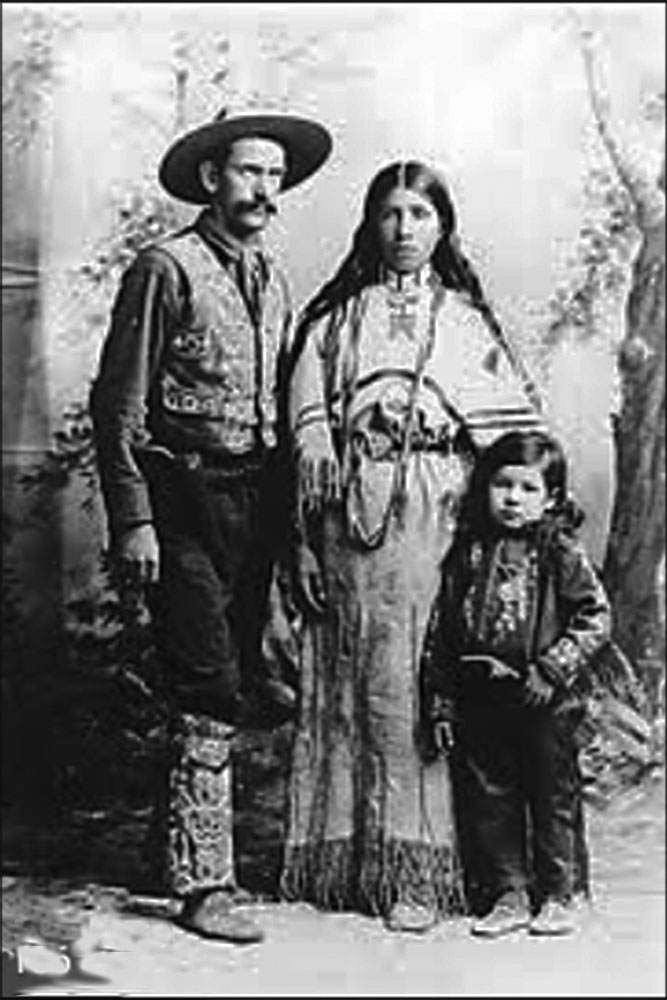 Some 'cowbooys' and 'Indians' married each other; shown here a buffalo hunter with his perhaps Sioux wife and daughter or son. image: unknown While only 2.9% of Americans identified as multiracial in the 2010 US census, many more will do so in the 2020 census. Moreover, DNA tests would probably show that over 10 or even 20% of Americans have more than 50% different racial roots. If we switch from multi-racial to multi-ethnic, we would probably surpass the half or even two-thirds mark.
Some 'cowbooys' and 'Indians' married each other; shown here a buffalo hunter with his perhaps Sioux wife and daughter or son. image: unknown While only 2.9% of Americans identified as multiracial in the 2010 US census, many more will do so in the 2020 census. Moreover, DNA tests would probably show that over 10 or even 20% of Americans have more than 50% different racial roots. If we switch from multi-racial to multi-ethnic, we would probably surpass the half or even two-thirds mark.
Indeed, many racists or neo-Nazis, if they were to take a DNA test, would be chagrined to note significant percentages not only of southern European heritage, which is hardly so-called Aryan stock, but Jewish and Black blood.
In the Black community, which is obviously very mixed, with European heritage sometimes exceeding African, some people feel the miscegenation was mostly due to rape. That may be true, but there also must have been some cooperation and love.
We know this because the cooperation and love we have today must have grown from something and because women are not weak. Indeed, they often struggle mightily—generally using radical centrist strategies—to benefit themselves and their children, including sometimes accepting oppressors as mates AND giving them love to increase their cooperation.
I have seen this phenomena between Jews and Germans during World War II through my research into my mother’s, her friends’ and other women’s experiences in the Holocaust.
As it happens, in addition to having 50% Jewish blood, DNA tests indicate that I have about .5% Native American heritage.
Admittedly, one two-hundredths a percent of heritage is not much to hang an identity on, but it does confirm family lore about an “Uncle Tomahawk.” As reprehensible as that nickname might be, it is notable that a Native American man was accepted into a Scottish-Irish family as the husband of one of their womenfolk eight generations ago, in 18th century Ohio.
Women are a different story, of course, given they were often taken as captive concubines, forced into marriage or raped, as was openly practiced in early slave days and continued clandestinely throughout the South, in violation of both human norms and claims of white superiority, which implies an abhorrence of congress with non-white women.
Nevertheless, the laws of attraction, the powers of seduction, the benefits of a powerful woman’s ability to comfort and comprehend still applied, regardless. Indeed, those “female powers” often wore down dominant or abusive men over decades of relationship—just as they do today in many power-imbalanced unions.
“Proper” social mores a century or two ago meant that intermarriages or mixed relationships were down played or completely hidden. Nevertheless, some of those women of color—who ranged from Black and Native in the South to Native, Latina AND Chinese in the West—came to exert enormous influence over their “white” husbands, children, families and communities, notably because they brought to bear expertise in different skills than typical white women.
Indeed, their hard work, their enormous hearts and their capacious courage should not be dismissed or forgotten or sullied by the notion that all imbalanced power relations are akin to rape. In point of fact, those women of color helped build the multicultural and mixed race society that many—dare I say most—of us enjoy to some degree or another— today. Moreover, for some of us, those women are our beloved grandmothers.
Hence, my suggestion to my fellow Americans:
Instead of focusing on our vast history of slavery, genocide, racism, White privilege and ongoing oppression—as we have for the last four months during the Black Lives Matter summer, which is essential, of course, but we can easily get back to that at any time— for the next month, let us turn to our equally significant heritage of multiculturalism and mixed marriages. It just might help us get through this difficult time of the 2020 election and stave off a period of inter-communal strife, if not a second civil war.
Even if we are not from a mixed marriage or mixed community, as I am—I had the privilege of growing up Jewish-gentile, across the street from Harlem, with Black, Latinx, Asian and southern European friends, and I have lived in West Oakland, another very mixed community, for 31 years—we have friends and enjoy culture and cuisine from those communities.
Moreover, we can look to “the better angels of our nature,” as was noted by our great radical centrist president, Abraham Lincoln, in his first inaugural address, one month before South Carolina started the Civil War.
Indeed, I suggest that we grab hold of our multicultural ideals, we increase our multicultural actions, we honor our multicultural grandmothers (and grandfathers), and we swing that spirit of mixing, tolerance and generosity as hard as we can.
The odds are about fifty-fifty, but if we swing hard enough, we just might make it. I wish us all good luck.
Doniphan Blair is a writer, film magazine publisher, designer, musician and filmmaker ('Our Holocaust Vacation'), who can be reached .
Posted on Oct 07, 2020 - 05:48 PM
by Doniphan Blair
Please support our stories by liking articles—thanks!
 'For every action, there is an equal and opposite reaction' is Isaac Newton's third law of motion. photo courtesy: Perpetual Motion Pendulum
'For every action, there is an equal and opposite reaction' is Isaac Newton's third law of motion. photo courtesy: Perpetual Motion Pendulumthat people rarely do as you say, but they often do as you do.
Hence, a common reaction to a revolution is counterrevolution, unless the previous regime was totally tyrannical. That is why revolutions, no matter how progressive, are obliged to be repressive.
The same is true when it comes to emphasizing tribe, profession, politics or other identifying factors. Your opponents pay you the highest compliment by doing not as you say but as you do—albeit from their perspective.
The truly brilliant revolutionary, therefore, is the radical centrist who resists the temptation to idealism, self-aggrandizement or score settling and is tolerant, generous and understanding of this normative feature of human nature. They fight for the most radical change possible, through a strategy of sophisticated moderation, while avoiding counterproductive counterrevolutions.
Which brings us into the teeth of America’s current catastrophe.
As Americans stagger through the quadruple threat of pandemic, social unrest, economic collapse and the most fraught election in memory, if not our history, we have a vast array of communities both at each other’s throats and arming themselves, sometimes literally, for escalated conflict, perhaps sanguineous.
But there is another story behind this narrative. For all America’s past slavery and genocide and ongoing prejudice and oppression, now inflamed by President Trump, it remains the most multicultural society on the planet.
How many Blacks, Jews, Italians, Irish or Mexicans does China have?
Even if China evolves beyond its repression of counterrevolutions, actual or perceived—like the Uighurs, over a million of whom are now in concentration camps—can it become a functional nation, let alone a super power, without the capacity to tolerate and integrate difference?
 Considered an 'Uncle Tom' by some radicals, Louis Armstrong largely invented modern jazz, was close friends with whites and Jews and smoked weed everyday of his adult life. image: The Louis Armstrong House Museum
Considered an 'Uncle Tom' by some radicals, Louis Armstrong largely invented modern jazz, was close friends with whites and Jews and smoked weed everyday of his adult life. image: The Louis Armstrong House Museum For a multicultural society to work, to efficiently organize the cooperation of people with different worldviews and practices, it requires a lot of radical centerists.
Yes, America seems like one long bloodbath to its immigrants, its forced immigrants and its First People—for good reason, of course—but it is not quite so grotesque after we compare America to other nations.
For a really long and vicious conflict try Islam, which is still fighting its civil war between the Sunnis and Shia, which started in the 7th century.
The Europeans had the Hundred Years War, the Eighty Years War, the Thirty Years War, the Seven Years War, and finally their magnum opus: the First and Second World Wars and the Holocaust, in which almost every European nation participated to some extent.
That three-part, 90-million-people, grave-digging contest only ended with American military intervention, including troops from all of our races, tribes and genders, and our financial generosity.
Sure, such comparisons are small comfort for people who have endured endless massacres, Jim Crow lynchings and other atrocities, many ongoing, if somewhat diminished.
Nevertheless, between America’s butchery and brutality, there was also a lot of assistance, cooperation, radical centerism and radical multiculturalism.
We know this from Frederick Douglas learning to read from white friends, or Louis Armstrong receiving his first trumpet from the warden of his juvenile prison, or from the fact that free people are curious people. Regardless of social standards or laws, they will explore their interests, be they intellectual or financial, emotional or sexual.
Indeed, along with our legal and political structure, the foundation of American society is its robust multiculturalism.
In addition to America’s open civic society—if only a work in progress AND currently under serious threat—America’s highest high culture and multicultural achievement is undoubtedly jazz.
Still, our immense interpenetration also produced humor, sports, fashion, art and religion as well as ever more music, from country, which borrowed extensively from Blacks, to rap.
For those who think rap is only Black, check out Run DMC’s “Walk This Way”, based on a riff from white rockers Aerosmith. Meanwhile, one of the biggest country hits of 2019 was “Old Town Road" by rapper Lil Nas X—20 years old, Black AND gay.
American multiculturalism has created not just culture but people.
 Some 'cowbooys' and 'Indians' married each other; shown here a buffalo hunter with his perhaps Sioux wife and daughter or son. image: unknown
Some 'cowbooys' and 'Indians' married each other; shown here a buffalo hunter with his perhaps Sioux wife and daughter or son. image: unknown Indeed, many racists or neo-Nazis, if they were to take a DNA test, would be chagrined to note significant percentages not only of southern European heritage, which is hardly so-called Aryan stock, but Jewish and Black blood.
In the Black community, which is obviously very mixed, with European heritage sometimes exceeding African, some people feel the miscegenation was mostly due to rape. That may be true, but there also must have been some cooperation and love.
We know this because the cooperation and love we have today must have grown from something and because women are not weak. Indeed, they often struggle mightily—generally using radical centrist strategies—to benefit themselves and their children, including sometimes accepting oppressors as mates AND giving them love to increase their cooperation.
I have seen this phenomena between Jews and Germans during World War II through my research into my mother’s, her friends’ and other women’s experiences in the Holocaust.
As it happens, in addition to having 50% Jewish blood, DNA tests indicate that I have about .5% Native American heritage.
Admittedly, one two-hundredths a percent of heritage is not much to hang an identity on, but it does confirm family lore about an “Uncle Tomahawk.” As reprehensible as that nickname might be, it is notable that a Native American man was accepted into a Scottish-Irish family as the husband of one of their womenfolk eight generations ago, in 18th century Ohio.
Women are a different story, of course, given they were often taken as captive concubines, forced into marriage or raped, as was openly practiced in early slave days and continued clandestinely throughout the South, in violation of both human norms and claims of white superiority, which implies an abhorrence of congress with non-white women.
Nevertheless, the laws of attraction, the powers of seduction, the benefits of a powerful woman’s ability to comfort and comprehend still applied, regardless. Indeed, those “female powers” often wore down dominant or abusive men over decades of relationship—just as they do today in many power-imbalanced unions.
“Proper” social mores a century or two ago meant that intermarriages or mixed relationships were down played or completely hidden. Nevertheless, some of those women of color—who ranged from Black and Native in the South to Native, Latina AND Chinese in the West—came to exert enormous influence over their “white” husbands, children, families and communities, notably because they brought to bear expertise in different skills than typical white women.
Indeed, their hard work, their enormous hearts and their capacious courage should not be dismissed or forgotten or sullied by the notion that all imbalanced power relations are akin to rape. In point of fact, those women of color helped build the multicultural and mixed race society that many—dare I say most—of us enjoy to some degree or another— today. Moreover, for some of us, those women are our beloved grandmothers.
Hence, my suggestion to my fellow Americans:
Instead of focusing on our vast history of slavery, genocide, racism, White privilege and ongoing oppression—as we have for the last four months during the Black Lives Matter summer, which is essential, of course, but we can easily get back to that at any time— for the next month, let us turn to our equally significant heritage of multiculturalism and mixed marriages. It just might help us get through this difficult time of the 2020 election and stave off a period of inter-communal strife, if not a second civil war.
Even if we are not from a mixed marriage or mixed community, as I am—I had the privilege of growing up Jewish-gentile, across the street from Harlem, with Black, Latinx, Asian and southern European friends, and I have lived in West Oakland, another very mixed community, for 31 years—we have friends and enjoy culture and cuisine from those communities.
Moreover, we can look to “the better angels of our nature,” as was noted by our great radical centrist president, Abraham Lincoln, in his first inaugural address, one month before South Carolina started the Civil War.
Indeed, I suggest that we grab hold of our multicultural ideals, we increase our multicultural actions, we honor our multicultural grandmothers (and grandfathers), and we swing that spirit of mixing, tolerance and generosity as hard as we can.
The odds are about fifty-fifty, but if we swing hard enough, we just might make it. I wish us all good luck.
Doniphan Blair is a writer, film magazine publisher, designer, musician and filmmaker ('Our Holocaust Vacation'), who can be reached .
Posted on Oct 07, 2020 - 05:48 PM














